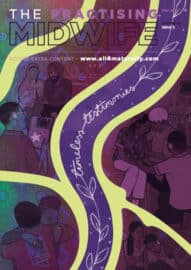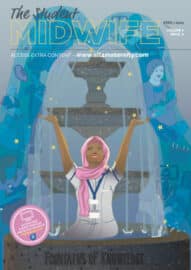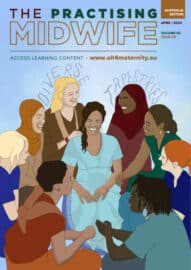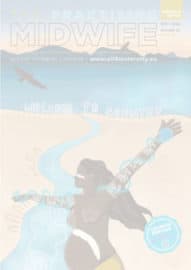Birthing Outside the System: The Canary in the Coal Mine. A book review
Dr Mari Greenfield ESRC Postdoctoral Fellow, King’s College London

Lack of autonomy
The main argument of the book is that the existence of a significant number of people choosing to give birth outside the standard maternity care systems points to serious underlying failures in those systems. The problems of a lack of autonomy and choice affect all those giving birth, whether they choose to birth within or outside of the system. A lack of autonomy and respect also affects their care providers, especially midwives. The book is a manifesto for those birthing within the system and outside the system – and for those providing care – to come together and make radical changes.
This book brings together a wide range of researchers and authors, including midwives, obstetricians, parents, academics and lawyers. They come from various countries, including Hungary, the Netherlands, India, the UK, Jordan, the USA, Croatia, Australia and Russia. The maternity systems they are investigating have significant differences, but the stories that they recount from both women and midwives are highly similar. In several places a history of the rise in freebirths, home births with unregulated care providers, or homebirths outside the guidelines are produced. I was surprised to find in these accounts that the rise of the ‘freebirth movement’ appears to have happened independently, in several unconnected countries, in a pre-internet age.
I loved the differentiation between biomedical safety, and safety from iatrogenic harm (including psychological harm), and I hope that this is a differentiation which clinicians who read the book will take seriously.
The issue of safety
One aspect which struck me very forcibly was the aspect of safety. When talking about freebirth, many maternity professionals and birth workers’ first concern will be about the risks and (un)safety of choosing a freebirth. In some chapters the authors are very clear to state that not all the women they researched made the choice to freebirth because of a previous bad experience. But in each chapter, most women report choosing to freebirth because of the lack of safety in a hospital birth. Their safety fears relate to complications that arise in hospital births – unnecessary interventions which cause iatrogenic harm and a higher risk of maternal morbidity and mortality, and damage to their mental health. Research shows these safety concerns to be realistic – and indeed in the last chapter of the book an obstetrician paints a stark picture of the medically induced harm that occurs in our maternity services, and how doctors rationalise causing this harm – yet these risks are rarely raised by most maternity professionals in risk discussions with pregnant women. The subject of cultural safety (ie, safety from racism and discrimination, including poor care, worse treatment, increased maternal mortality and morbidity, increased infant mortality, and child removal) is also raised repeatedly. I would have liked to see this extended to other aspects where a birthing person may experience differences in care, such as disability, gender identity, or sexual orientation. I loved the differentiation between biomedical safety, and safety from iatrogenic harm (including psychological harm), and I hope that this is a differentiation which clinicians who read the book will take seriously.
Limiting women
The book weaves a tale of limits placed around women. Limits placed directly on their choices. Legal limits placed on their human rights once they are pregnant. Criminal prosecutions and convictions for miscarrying or declining medical interventions such as caesarean sections. Limits placed on their choice of an attended homebirth, by making it illegal for a registered midwife to attend someone who has any risk factors. Limits placed through coercive language, implying that women do not have a choice. Where women know they legally have a choice, limits being introduced by implying that they are bad and irresponsible mothers if they have come to a different conclusion about what constitutes ‘safety’ for them and their baby. The picture painted is of birthing people hemmed in further and further, until there is only a small space in which they can give birth – a space where they unquestioningly follow all medical recommendations, regardless of the physical and mental trauma they experience in doing so.
The accounts of poor treatment contained in the stories in this book should shock any reader, but I worry that some practitioners may read accounts of physical violence being used against labouring women, and believe that this is unrelated to anything that happens in their practice. As this book makes clear, emotional coercion, verbal humiliation, physical mistreatment and legal prosecution are part of a continuum that is caused by believing the pregnant women is less worthy, less rational, and cares less about their baby than the maternity professional ‘caring’ for them. Interestingly, the stories from economically poorer countries make explicit the link between the poor care, including verbal and physical abuse, received by women from low grade maternity professionals (mostly nurse midwives), and the poor professional recognition those workers receive from those higher up. This link is not made as explicitly in the chapters relating to wealthier countries, though the overarching theme of the book – of a toxic maternity system which is poisoning all those who birth or work in it – does make this point. Interestingly in these chapters, the link between the greater scrutiny of midwives when compared to other maternity health care providers is linked to the legal and financial restrictions imposed on women trying to exercise choice in care.
Unregulated birth practitioners
In various chapters the role of unregistered and/or unregulated birth attendants is also raised. The variety in the countries and systems covered is reflected in the variety of such attendants, and includes Traditional Birth Attendants, doulas, and trained and experienced midwives who are licenced to practice in one country or State who cross borders to serve women. It is interesting to note that, like freebirth itself, these roles have arisen independently and from different roots, but have become a global phenomenon as they meet the needs of women around the globe who are not willing to birth in the system, but don’t wish to birth alone. The existence of such unregulated birth practitioners is often seen only as problematic in birth literature, and it is heartening to see the thoughtfulness with which the subject is approached in these chapters. The book neither calls for the eradication of such roles, nor for the wholesale regulation of the people (largely lowly paid women) who carry them out. Instead, different chapters examine the differing local context in which those roles have arisen, and propose local solutions, all of which involve greater respect for the autonomy of the pregnant or labouring person. The authors also make explicit the link between how midwifery as a whole has been seen in recent historical times, modern day ‘witch hunts’ against midwives who uphold women’s autonomy, and how unregulated birth workers are described today.
Dehumanised care
This book is also a call to take birth trauma more seriously. Whilst not everyone who chooses a freebirth does so because of a traumatic birth, as the stories in this book make clear, a substantial number do. There are harrowing stories from women of appalling intrapartum care, and vivid descriptions of the emotional and psychological trauma that this continues to cause for birthing people and their families for the rest of their lives. Several chapters in the book also reference the fact that suicide is a leading cause of maternal perinatal death in many Western countries, and link this fact directly to the high rates of birth trauma that are caused by our maternity systems.
The voices of women of colour, both authors and participants, come through the book strongly. There are stories from and about Black women in the US, both Aboriginal and Asian women in Australia, and Roma women in Eastern Europe. Brief histories of indigenous, enslaved and migrant midwives and midwifery practices are also given. The evidence presented in these stories is clear – racism, classism, ableism and misogynoir add extra dimensions to the generalised mistreatment of pregnant and labouring women across the world, and to the mistreatment of midwives from ethnic minorities in each country. The prominence given to these voices is timely for readers like me in the UK; the latest MBRRACE report shows that Black women are 5 times more likely to die in childbirth in the UK, and Asian women are 2 times more likely to die, but many birth workers are struggling to understand the reasons behind those figures. The accounts by and about women of colour contained in these chapters tells us the unpalatable truth – dehumanising care which ignores women’s own knowledge about their bodies and their babies is a commonplace experience for birthing women of colour in our maternity systems. Whilst we struggle with the ideas that women are mistreated; that racism makes mistreatment more likely and more severe; and that the mistreatment can result in both life-threatening complications and suicide, women are literally dying. In this context, the choice to birth outside of guidelines, and outside of the system, is surely the most logical choice.

The book is also a manifesto for change, and therefore for hope. Building better, more trusting, and respectful relationships is key. Better relationships between maternity systems and those who practice on the edges of the system, more trusting relationships between hospital staff and homebirth midwives, and respectful relationships between pregnant people and maternity professional
Time for change
The book is also a manifesto for change, and therefore for hope. Building better, more trusting, and respectful relationships is key. Better relationships between maternity systems and those who practice on the edges of the system, more trusting relationships between hospital staff and homebirth midwives, and respectful relationships between pregnant people and maternity professionals. Several of the chapters towards the end of the book make the case for specific tools to be implemented in specific countries, or for specific kinds of births, and many of these suggestions sound positive. Sadly, even in some of these chapters, the tensions between women’s rights to choose, and midwifery’s vulnerability and susceptibility to ‘witch hunts’ can be seen, with the language used in some proposals suggesting women need to comply with certain assessments in order to access specific settings for care.
I like that each individual chapter ends with a summary by the authors of the changes they feel are most essential. It is heartening to hear so many diverse voices threaded throughout the book, calling for the same things. From parents, academic researchers, midwives and obstetricians, similar demands are heard – woman-centred care, which allows individuals to really make the choices about their own bodies and babies, whilst being supported by knowledgeable and respected/respectful midwives, who in turn are supported by obstetric colleagues when needed. In the conclusion, these summaries are woven together to create a plan for change in maternity care, which would work worldwide. Though grouped into a simple 5 points, the plan is detailed and thorough, and challenging. If readers of this book are able to take on this challenge, it could lead to a revolution in maternity care.
#ENOUGH
Birthing Outside the System: The Canary in the Coal Mine
Hannah Dahlen (Editor), Bashi Kumar-Hazard (Editor), Virginia Schmied (Editor)
Routledge Research in Nursing and Midwifery
2020, Routledge, 488 pp, hbk, £105.60, ISBN 978-1138592704







